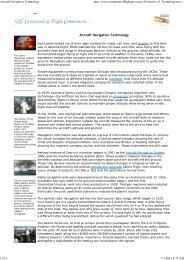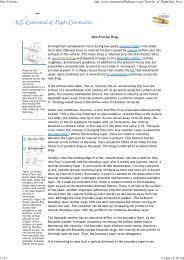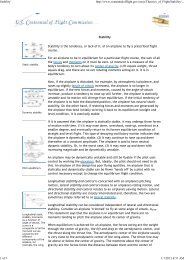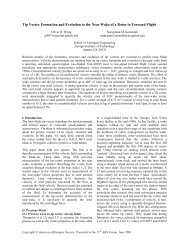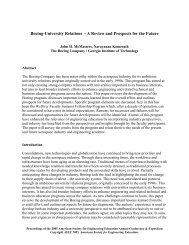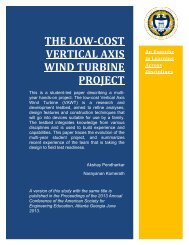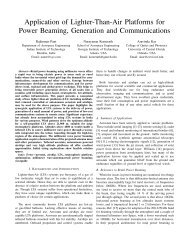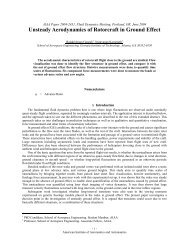(Performance \226 Class 1 Airplane Motions)
(Performance \226 Class 1 Airplane Motions)
(Performance \226 Class 1 Airplane Motions)
You also want an ePaper? Increase the reach of your titles
YUMPU automatically turns print PDFs into web optimized ePapers that Google loves.
<strong>Performance</strong> – <strong>Class</strong> 1 <strong>Airplane</strong> <strong>Motions</strong>http://www.centennialofflight.gov/essay/Theories_of_Flight/performan...2 of 3 1/1/2011 8:49 AMFigures (a) and (b)show the forcesystems for anairplane in astraight-constantvelocity climb ordive an angle to thehorizontal directionof flight.gamma], respectively. If the forces are summed parallel and perpendicular tothe flight path, it is seen that the weight force is resolved into two components.One obtainsL = W cos y = W cos (-y ) (Climb or dive)T = D + W sin y (Climb)T = D + W sin (-y ) = D - W sin y (Dive) (1)To maintain a straight climbing (or diving) flight path, the lift equals thecomponent of weight perpendicular to the flight path.L = W cos y = W cos (-y)In the case of the climb condition to maintain a constant velocity, the thrustmust equal the drag plus a weight component retarding the forward motion ofthe airplane. In the case of the dive condition, the weight component along theflight path helps the thrust by reducing the drag component for constantvelocity.This figure showsthe force systemsfor an airplane in astraight, constantvelocity verticalclimb (straight up).The conclusion is that one must use an increased thrust to climb at constantvelocity and use less thrust to dive at constant velocity. This is analogous to thesituation of a car where one must "give it the gas" (apply more thrust) toprevent the car from slowing down in going up a hill and "let up on the gas" (useless thrust) to prevent the car from speeding up when going down a hill.It is interesting also to examine three special cases of the use of the aboveequations. First, in straight and level flight, the climb angle y is zero, hence siny = 0 and cos y = 1. This yields the previously derived conditions that Lift =Weight (L = W) and Thrust = Drag (T = D). Secondly in a vertical climb y = 90°,and hence sin y = 1 and cos y = 0. Thus, the thrust necessary to climb verticallyis equal to the drag plus the airplane weight (T = D + W). Also, for a verticalclimb, the lift equals zero (L = 0).The final condition to be discussed is gliding flight. In gliding flight, the thrustequals zero. It is therefore necessary to balance the forces of lift and drag withthe weight. Equation (2) remains unchanged but equation (1) is simplified. In aglide:L = W cosy g (2)D = W siny g (3)If one divides equation (2) by equation (3), the result is:L/D = 1/tany gIn nonmathematical language, this means that the smallest glide angle, andhence maximum gliding range, is obtained when the lift-drag ratio is themaximum. The lift-drag ratio is a measure of the aerodynamic efficiency of theairplane. Sailplanes possess the greatest lift-drag ratios with excellentaerodynamic design since they rely on air currents to keep them aloft. For aparticular airplane, the lift-drag ratio varies with the angle of attack of theairplane (not to be confused with the glide angle of the flight path). There is aparticular angle of attack for which this ratio is a maximum. This is then theangle of attack for minimum glide angle and maximum range. For any otherangle of attack, the lift-drag ratio is less and the glide angle is increased; hence,a steeper glide results. It is a natural tendency for a pilot to raise the airplane'snose (increase the angle of attack) to try to get maximum range, but unless thisgives the maximum lift-drag ratio, the descent will be steeper instead.


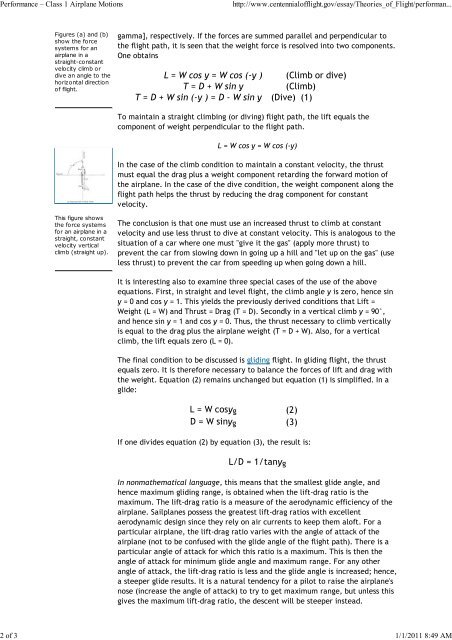
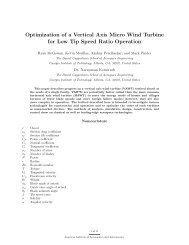
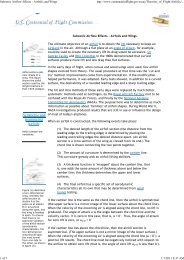

![p density of fluid, kg/m3 [Greek letter rho] V mean velocity of fluid, m ...](https://img.yumpu.com/50595898/1/184x260/p-density-of-fluid-kg-m3-greek-letter-rho-v-mean-velocity-of-fluid-m-.jpg?quality=85)
